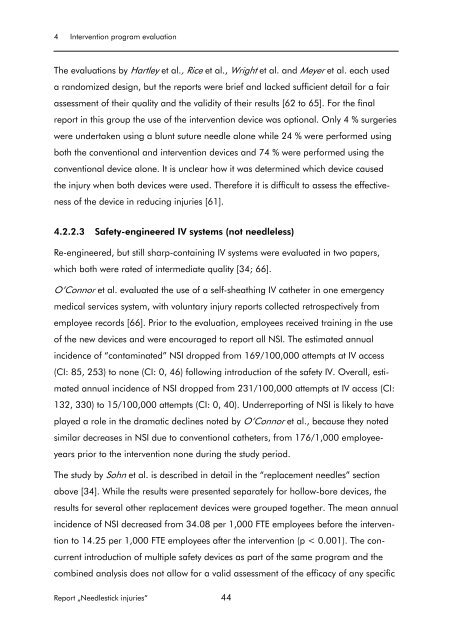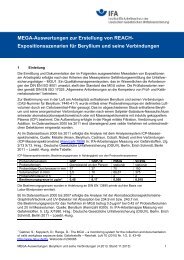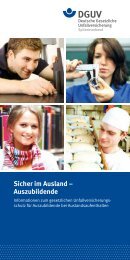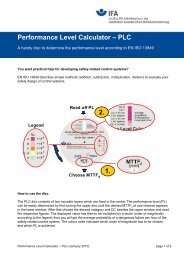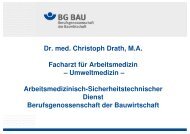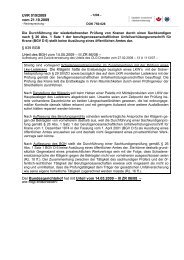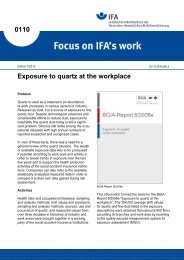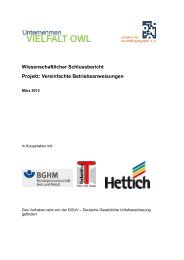Effectiveness of measures to prevent needlestick injuries among ...
Effectiveness of measures to prevent needlestick injuries among ...
Effectiveness of measures to prevent needlestick injuries among ...
You also want an ePaper? Increase the reach of your titles
YUMPU automatically turns print PDFs into web optimized ePapers that Google loves.
4 Intervention program evaluation<br />
The evaluations by Hartley et al., Rice et al., Wright et al. and Meyer et al. each used<br />
a randomized design, but the reports were brief and lacked sufficient detail for a fair<br />
assessment <strong>of</strong> their quality and the validity <strong>of</strong> their results [62 <strong>to</strong> 65]. For the final<br />
report in this group the use <strong>of</strong> the intervention device was optional. Only 4 % surgeries<br />
were undertaken using a blunt suture needle alone while 24 % were performed using<br />
both the conventional and intervention devices and 74 % were performed using the<br />
conventional device alone. It is unclear how it was determined which device caused<br />
the injury when both devices were used. Therefore it is difficult <strong>to</strong> assess the effective-<br />
ness <strong>of</strong> the device in reducing <strong>injuries</strong> [61].<br />
4.2.2.3 Safety-engineered IV systems (not needleless)<br />
Re-engineered, but still sharp-containing IV systems were evaluated in two papers,<br />
which both were rated <strong>of</strong> intermediate quality [34; 66].<br />
O’Connor et al. evaluated the use <strong>of</strong> a self-sheathing IV catheter in one emergency<br />
medical services system, with voluntary injury reports collected retrospectively from<br />
employee records [66]. Prior <strong>to</strong> the evaluation, employees received training in the use<br />
<strong>of</strong> the new devices and were encouraged <strong>to</strong> report all NSI. The estimated annual<br />
incidence <strong>of</strong> “contaminated” NSI dropped from 169/100,000 attempts at IV access<br />
(CI: 85, 253) <strong>to</strong> none (CI: 0, 46) following introduction <strong>of</strong> the safety IV. Overall, esti-<br />
mated annual incidence <strong>of</strong> NSI dropped from 231/100,000 attempts at IV access (CI:<br />
132, 330) <strong>to</strong> 15/100,000 attempts (CI: 0, 40). Underreporting <strong>of</strong> NSI is likely <strong>to</strong> have<br />
played a role in the dramatic declines noted by O’Connor et al., because they noted<br />
similar decreases in NSI due <strong>to</strong> conventional catheters, from 176/1,000 employee-<br />
years prior <strong>to</strong> the intervention none during the study period.<br />
The study by Sohn et al. is described in detail in the “replacement needles” section<br />
above [34]. While the results were presented separately for hollow-bore devices, the<br />
results for several other replacement devices were grouped <strong>to</strong>gether. The mean annual<br />
incidence <strong>of</strong> NSI decreased from 34.08 per 1,000 FTE employees before the interven-<br />
tion <strong>to</strong> 14.25 per 1,000 FTE employees after the intervention (p < 0.001). The con-<br />
current introduction <strong>of</strong> multiple safety devices as part <strong>of</strong> the same program and the<br />
combined analysis does not allow for a valid assessment <strong>of</strong> the efficacy <strong>of</strong> any specific<br />
Report „Needlestick <strong>injuries</strong>“ 44


